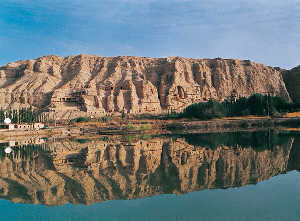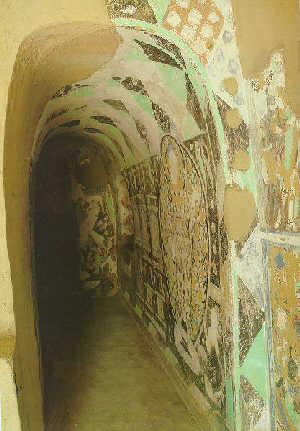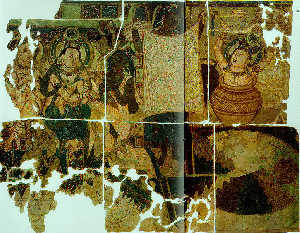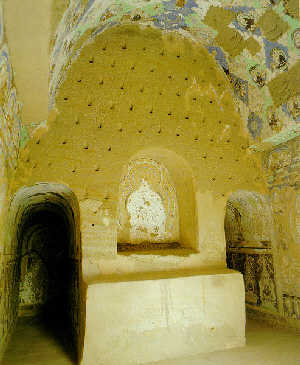| |
Grotto Art
( 2005-09-13 )

Around the first century BC, Buddhism, born in India, was introduced into Xinjiang through Kashmir. Soon after, it became the main religion in the region thanks to efforts made by the local rulers to promote it. At its peak, Buddhist temples mushroomed in the oases around the Tarim Basin with large numbers of monks and nuns. Yutian, Shule, Qiuci and Gaochang were all centers of Buddhism. In Xinjiang, Buddhist culture reached a very high level, leaving a precious cultural heritage of statues, paintings, music, dancing, temples, and sacred grottoes, greatly enriching the cultural and art treasury of China and the world.

By the Seventh century all the small kingdoms of the Tarim region had been entirely won over to Buddhism, which brought with it so much of Indian culture that Sanskrit had become the religious language. As Buddhism advanced towards the Tarim basin, Kashgaria with Yarkand and Khotan in the west, Tumsuk, Aksu and Kizil in the north, Loulan, Karasahr and Dunhuang in the east, and Miran and Cherchen in the south became important centers of Buddhist art and thought.

The Buddhist texts were translated from Sanskrit into various local Indo-European dialects such as Tocharian or Kuchean. By 658 AD, Kucha developed to be a leading center of Hinayana Buddhism and the paintings were found at the cave temples of Kizil (near Kucha) dated from the First to Eighth centuries. The early art form in the Tarim area were strongly Indo-Persian in style, but Persian elements were gradually overlaid by the Chinese in the 6th century after Tang's power dominated the Tarim basin.
It is impossible to make any general rules about the precise schools of Buddhism that flourished in the Tarim Basin, but the early pilgrims who traveled there gave some clues. Fa-hsien and Xuan Zang appeared to indicate that most of the kingdoms such as Kashgar, Kizil, Karashahr and Kucha on the northern route followed the Hinayana Vehicle whereas Mahayana flourished along the southern route including the kingdoms of Khotan and Yarkand.
 The decline of Buddhism along the Silk Road was due to the collapse of the Tang Dynasty (618-907AD) in the East and the invasion of Arabs in the West. The conversion to Islam started in the Eighth century in Central Asia. Since Islam condemned the iconography, most of the Buddhist statues and wall paintings were damaged or destroyed. Buddhist temples and stupas were abandoned and buried beneath the sand. By the 15th century, the entire Central Asia basin had been converted to Islam. The decline of Buddhism along the Silk Road was due to the collapse of the Tang Dynasty (618-907AD) in the East and the invasion of Arabs in the West. The conversion to Islam started in the Eighth century in Central Asia. Since Islam condemned the iconography, most of the Buddhist statues and wall paintings were damaged or destroyed. Buddhist temples and stupas were abandoned and buried beneath the sand. By the 15th century, the entire Central Asia basin had been converted to Islam.
Now the remaining well-preserved grottos are mainly distributed in the ancient Qiuci area (in the area of today's Kuche, Xinhe and Shaya), including four key sites under State protection: Kizil Grottos, Kumutula Grottos, Kizilgaha Grottos, Senmusaimu Grottos and four key sites under Autonomous Regional protection: Taitai'er Grottos, Mazhaboha Grottos, Tuohulake'aiken Grottos and Wenbashi Grottos.
|
|

